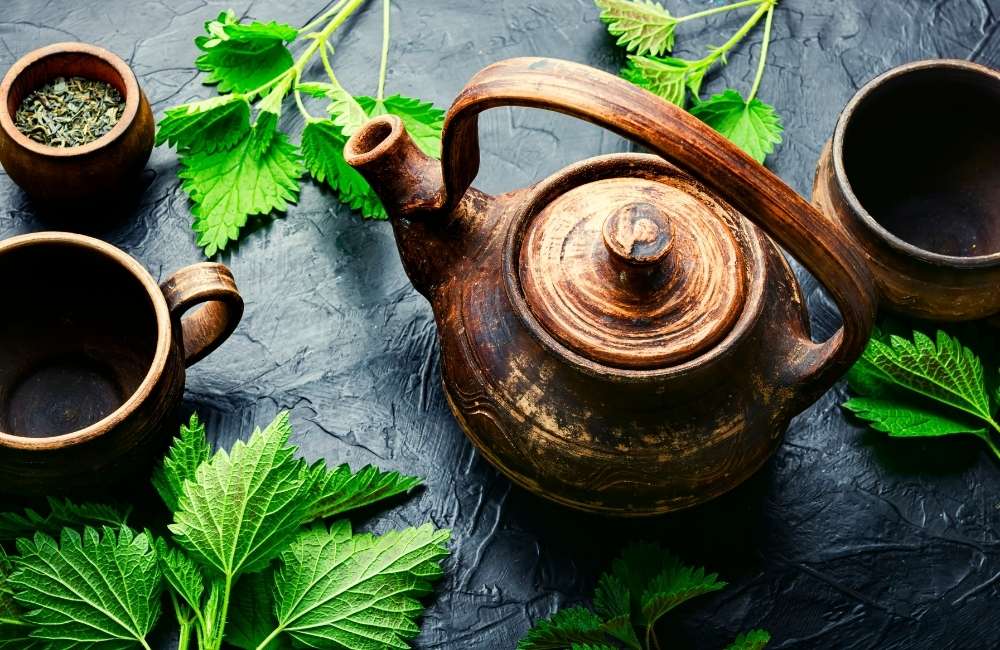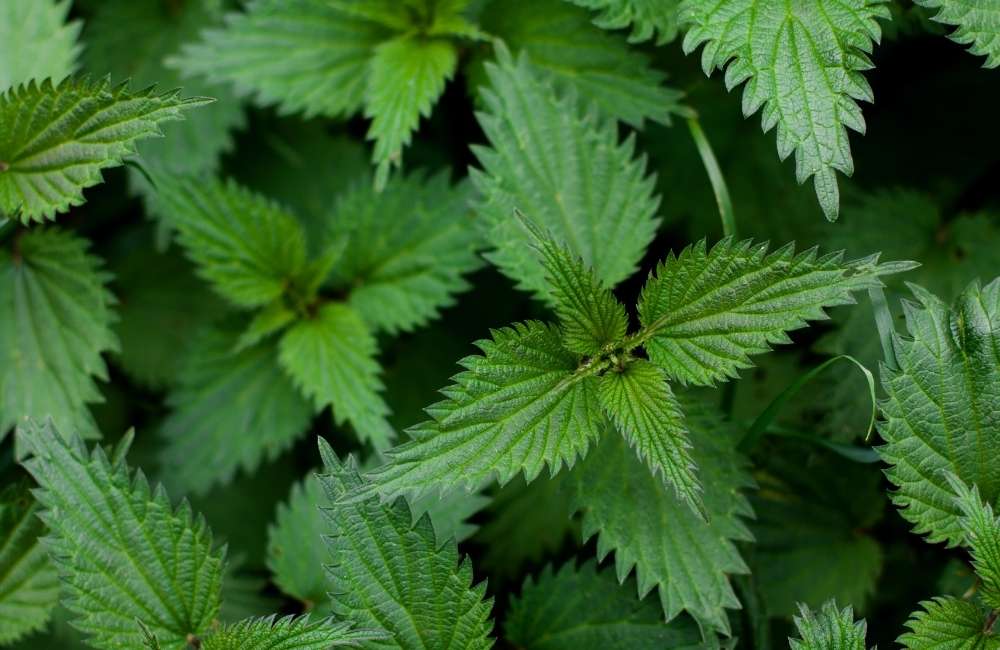Stinging nettle (Urtica Dioica) is a herbaceous plant belonging to the family of Urticaceae. It can grow between 1-2m tall and it is perennial with rhizomes.
The plant is characterized by unicellular stinging hairs. The erect stems are strong, hairy, mostly unbranched and quadrangular. They are green in young plants and purple/reddish in older plants.
The leaves and stems are very hairy and bear many stinging hairs whose tips come off when touched, transforming the hair into a needle that injects a stinging liquid.
The plant is dioecious having separate male and female plants that flower from June to September. The flowers are unisexual.
The root system is composed of a taproot which branches into fine rootlets allowing the tuft nettle to expand.
It is native to Eurasia and was widely distributed throughout all the temperate regions of the world. It is now found more in Northern Europe, Northern Africa, Asia, and North and Southern America where it is also largely widespread.
Stinging nettle has been used for over 2,000 years as a natural remedy for its therapeutic properties. In recent times a lot of studies have been conducted on the plant and amazingly a lot that was known traditionally were confirmed and new properties discovered.
Its content has been discovered to be highly responsible for most of its pharmacological properties. Let us have a look at some of these contents:
Nutritional Content of Stinging Nettle
Stinging nettle leaves and roots provide a wide variety of nutrients which includes:
- Amino Acids: All the essential amino acids.
- Vitamins: Vitamins A, C, D, E and K, as well as several B Vitamins (B1, B2, B3, B9).
- Minerals: Calcium, iron, magnesium, Phosphorus, potassium and sodium
- Fats: Linoleic acid, linolenic acid, palmitic acid, stearic acid and oleic acid.
- Pigments: Beta-carotene, lutein, luteoxanthin and other carotenoids.
Phytochemical Content of Stinging Nettle
The Leaves: These are rich in flavonoids, phenolic compounds, organic acids, vitamins and minerals
The Roots: The roots contain lecithin, polysaccharides, sterols and lignans.
The Liquid in the Plant’s Hair: The stinging action of the nettle is due to the liquid contained in the hair this liquid contains three compounds that could be the cause of the allergic reaction and they are:
- Acetylcholine
- Histamine
- Serotonin
The flavonoids include:
- Quercetin
- Kaempferol
- Rutin
- Caffeic acid
- Coumarins and other flavonoids.
Traditional Medicinal Uses of Stinging Nettle
Traditionally the nettle plant has been used for medicinal purposes before research work started. In Morocco, all parts of the plant are used in traditional medicine.

The Whole Plant: The whole plant can be used as a diuretic, anti-hypertensive, anti-diabetic, hemostatic, anti-asthenia, anti-anaemic, antispasmodic, anti-rheumatic and a remedy for headaches and chills.
It is also used to treat spleen, renal and dermal disorders.
The Seeds: The seeds are used orally for their aphrodisiac and galactagogue effects. They are also used for tuberculosis and kidney stones.
External uses include the treatment of aphthae, haemorrhoids, scabies and pruritus.
Health Benefits of Stinging Nettle
Many of its phytochemical contents act as anti-oxidants inside the body and hence can help defend your cells against damage from free radicals that can cause a wide range of disease conditions.
Let us have a look at various conditions that this herb can take care of that have been proven through research not just by handover from our fathers traditionally. They include:
-
Reducing Seasonal Allergy
Research has shown that stinging nettle extracts can inhibit inflammation that can trigger seasonal allergies which occur when a substance, such as pollen, triggers the body to produce histamine. Histamine causes characteristic symptoms of an allergic reaction, such as inflammation, itching, and hives (raised itchy rash). There is currently insufficient evidence through research to prove this.
-
Relief From Arthritis
Some studies suggest that the extracts may have anti-inflammatory properties. Inflammation is your body’s way of healing itself and fighting infections. However, chronic inflammation can inflict significant harm. It contains a variety of compounds that may reduce inflammation and could assist in treating symptoms of rheumatoid arthritis, osteoarthritis and gout but more research is needed.
-
May Treat Symptoms of Enlarged Prostrate
An enlarged prostate is referred to as benign prostatic hyperplasia (BPH). There is no known cause of BPH that science has discovered but the condition can lead to significant discomfort during urination and up to 50% of men aged 51 and older have an enlarged prostate gland.
Some studies have suggested that extracts of stinging nettle may help treat BPH by preventing the conversion of testosterone into dihydrotestosterone (a more powerful form of testosterone). This action can help reduce prostate size thereby relieving the discomfort of an enlarged prostate(BPH).
-
May Help to Lower Blood Pressure
This herb has been used traditionally to manage high blood pressure and researchers have equally proven that it may help to lower blood pressure.
The lowering of blood pressure by the extract suggests it could be through several ways which may include:
- Stimulation of nitric oxide production, which acts as a vasodilator that relaxes the walls of the blood vessels, helping them to widen.
- It has compounds that may act as calcium channel blockers, which relax your heart by reducing the force of contractions.
- Raising the heart’s antioxidant defences.
High blood pressure is a serious health concern because it puts you at risk of heart disease and strokes, which are among the leading cause of death worldwide. More research is however needed in this area.
-
May Aid Blood Sugar Control
In human and animal studies, it has been shown that stinging nettle can lower blood sugar levels. It contains compounds that may mimic the effects of insulin. More human studies are crucial before recommendations can be made.
-
May Have Effect on Platelet Aggregation
Several studies have shown that the extracts strongly inhibit platelet aggregation. This makes it act as a blood thinner and this is due to the flavonoid content of nettle.

There are other potential benefits of stinging nettle which still need to be researched and they include:
- Reduced Bleeding: medication containing the extract containing have been found to reduce excessive bleeding, especially after surgery.
- Liver Health: Stinging nettle’s antioxidant properties may protect the liver against toxins, heavy metals and inflammation.
- Natural Diuretic: The extract may help shed excess salt and water, which in turn lowers the blood pressure temporarily.
- Wound and Burn Healing: Stinging nettle cream may support wound healing, including burn wounds.
Side Effects of Stinging Nettle
The leaves have hair-like structures that sting and also produce itching, redness and swelling but once it is processed into a supplement, dried, freeze-dried or cooked, stinging nettle can safely be consumed by most people. However, there are a few side effects that we have to still mention in this write-up and they include:
- The hair-like barbs on fresh stinging nettle leaves can harm the skin by injecting an array of chemicals (acetylcholine, histamine, serotonin, leukotrienes, formic acid) that can cause rashes, bumps, hives and itchiness. In some cases, severe, life-threatening allergic reactions.
- It can trigger uterine contractions in pregnant women which may cause miscarriage.
- Stomach problems
- Urinary issues
- Diarrhoea
- Sweating
Children should avoid using stinging nettle as there are no official safety guidelines for use in children.
Interaction with Medications
If taking any of these medications listed below, you should speak to your doctor first before taking any stinging nettle supplement as it may potentiate their actions in your body:
- Blood thinners
- Blood pressure medication
- Diuretics (water pills)
- Diabetes medication
- Lithium
Ways You Can Consume Stinging Nettle
Stinging Nettle can be purchased in many health food stores and can also be grown in our gardens but when harvesting protective gloves have to be worn. Stinging nettle can be consumed as follows:
- Dried/freeze-dried leaves and flowers sold in health food stores: These can be steeped to make delicious herbal tea.
- Capsules are sold as supplements in pharmacies.
- Tinctures
- Creams
- Ointments: These are often used to ease osteoarthritis symptoms.
Presently, there is no recommended dosage for stinging nettle products but some studies suggest that for enlarged prostate, 360mg of the root extract is the most effective in reducing enlarged prostate in BPH.
For allergies, 600mg of freeze-dried leaves per day is the most effective.
Conclusion
Stinging nettle is a wonder plant considering all that we have mentioned earlier. Though, notorious for its unpleasant irritant effects, stinging nettle is rich in vitamins and minerals and possesses many medicinal properties.
Although the potential benefits of stinging nettle are still not entirely defined, many studies have strengthened its claimed indications from traditional medicine.
It is usually safe, but it may cause some side effects. It is therefore pertinent to speak with your doctor before using stinging nettle to treat any condition, as it may interact with some medications.
This write-up is intended for enlightenment purposes and not for you to start using any stinging nettle product without consulting with your doctor as advised already. We keep creating awareness of the boundless blessings of nature as discovered in old and presently trying to be re-established for modern-day benefits. Thank you for reading!

